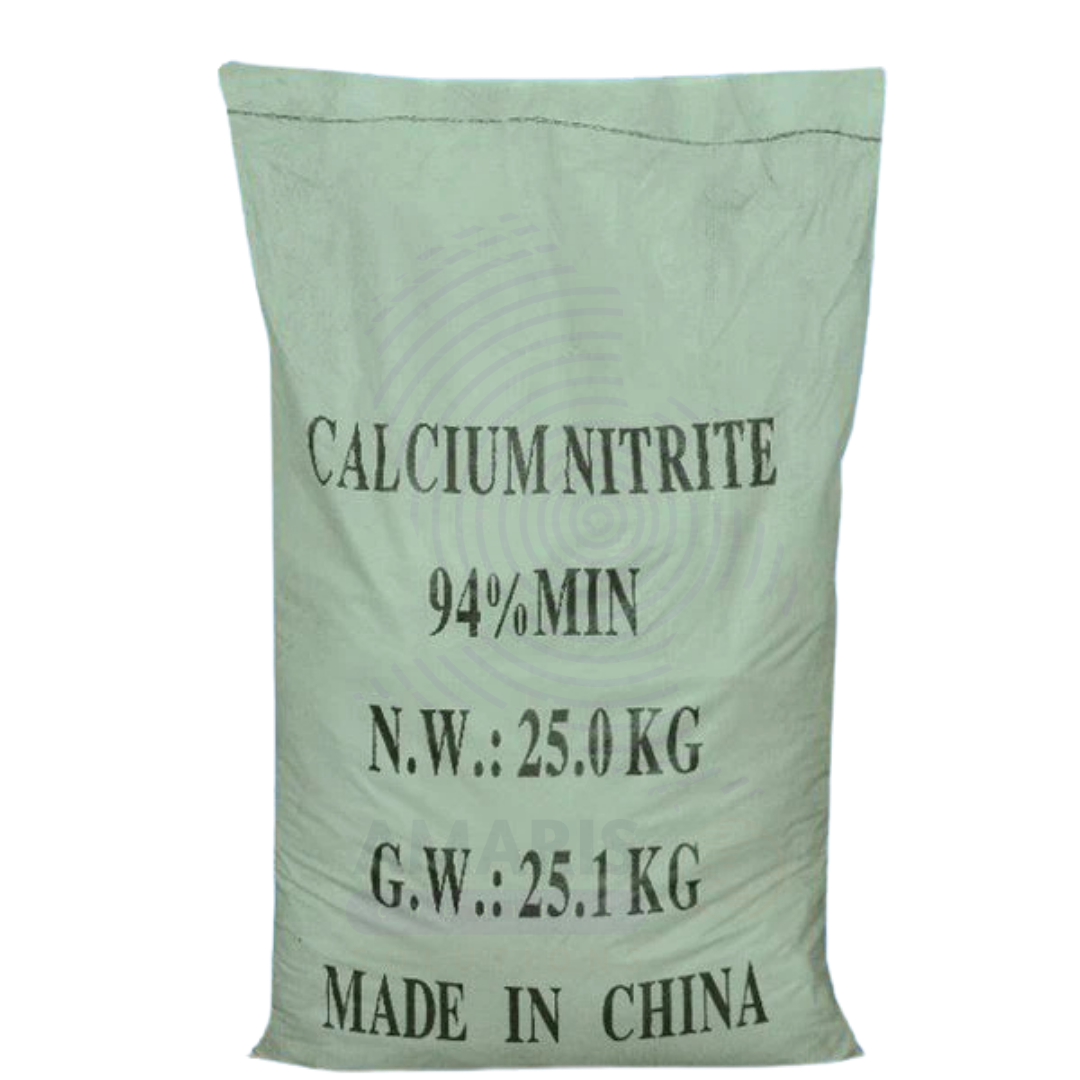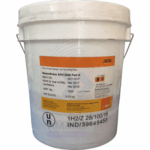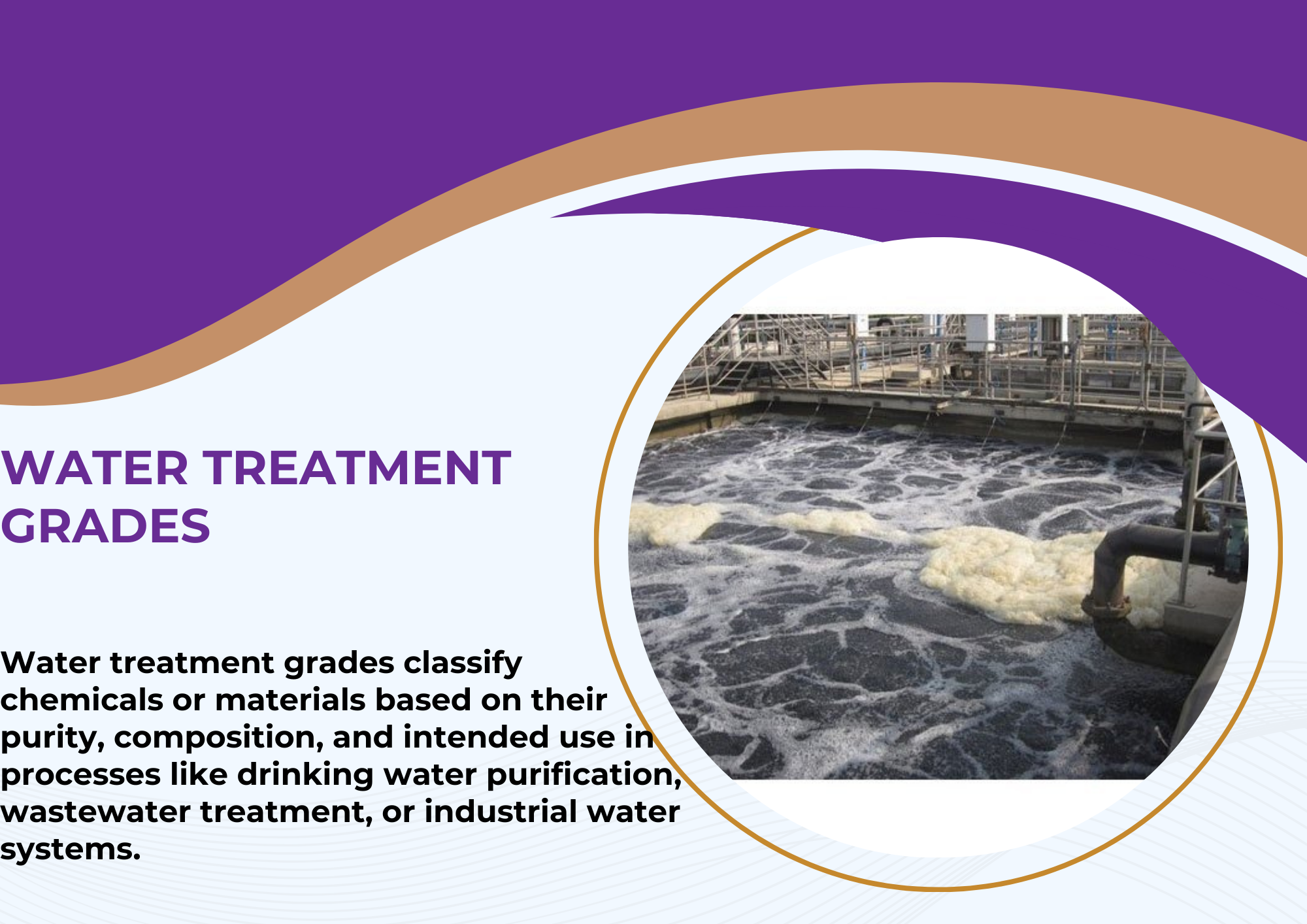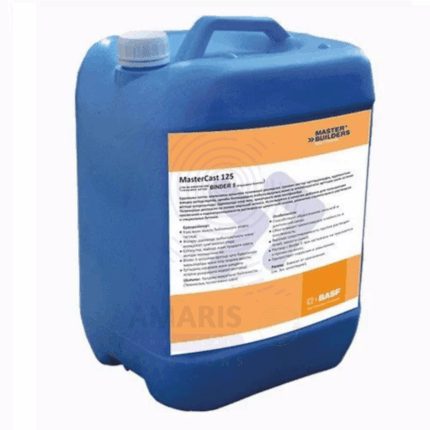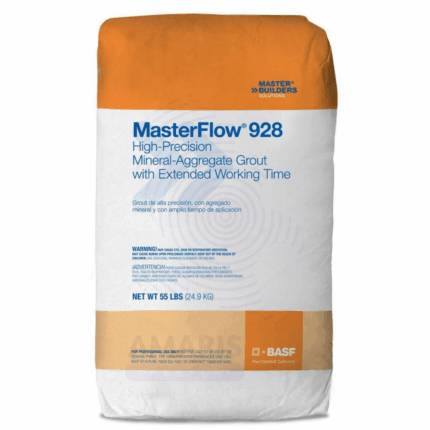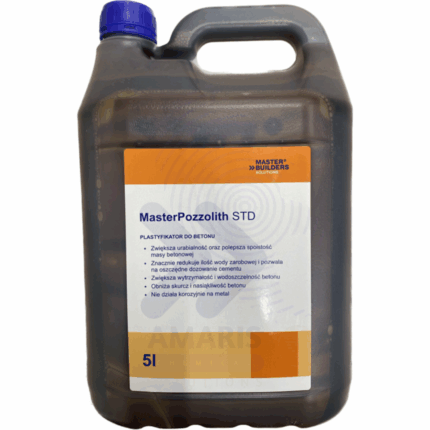Calcium Nitrite
Whatsapp Order
Calcium Nitrite is an inorganic compound commonly supplied as a white crystalline powder or granules. It serves primarily as a corrosion inhibitor in reinforced concrete structures, protecting steel reinforcement from rust and prolonging structural lifespan. Calcium nitrite is also used in various industrial processes as an oxidizing agent and preservative. Due to its high solubility in water and strong oxidizing properties, it effectively prevents chloride-induced corrosion and improves concrete durability.
Description
Table of Contents
Toggle
Calcium Nitrite
Primary Uses
- Construction & Civil Engineering
- Used as a corrosion inhibitor in reinforced concrete to protect steel rebars from chloride-induced corrosion.
- Added to concrete mixes to enhance durability and prevent premature deterioration, especially in marine and industrial environments.
- Helps in extending the service life of concrete structures such as bridges, tunnels, and parking garages.
- Industrial Applications
- Employed as an oxidizing agent in various chemical manufacturing processes.
- Acts as a nitrosating agent and preservative in some industrial and food applications (subject to regulatory approval).
Secondary Uses
- Water Treatment
- Used occasionally as a biocide and corrosion inhibitor in cooling water systems and boilers.
- Agriculture
- Sometimes incorporated in fertilizers to provide nitrogen in nitrite form and improve nitrogen efficiency (limited use).
KEY PRODUCT FEATURES
1. Basic Identification Attributes
- Chemical Name (IUPAC): Calcium dinitrite
- Common/Trade Name: Calcium Nitrite
- CAS Number: 13780-06-8
- HS Code: 2834.29.00
- Molecular Formula: Ca(NO₂)₂
- Synonyms:
- Calcium dinitrite
- Calcium nitrite salt
- Calcium(II) nitrite
2. Physical & Chemical Properties
- Physical State: Crystalline powder or granules
- Color & Odor: White to off-white; odorless
- Melting Point: Decomposes at ~400°C
- Boiling Point: Not applicable (decomposes)
- Density: Approx. 2.18 g/cm³ (anhydrous)
- Solubility: Highly soluble in water (~81 g/100 mL at 20°C); insoluble in alcohol
- pH: Slightly alkaline in aqueous solution (pH ~9–10)
- Stability: Stable when dry; sensitive to moisture and heat
3. Safety & Hazard Attributes
- Hazard Class (GHS): Oxidizing solid (Category 3); harmful if swallowed or inhaled
- NFPA Ratings:
- Health: 2
- Flammability: 0
- Reactivity: 1
- Exposure Limits: Avoid inhalation of dust; no specific OSHA PEL but general dust limits apply
- Toxicity: Moderate toxicity; ingestion or inhalation may cause irritation to respiratory and digestive tracts
- Reactivity: Strong oxidizer; reacts with reducing agents and combustible materials
4. Storage & Handling Attributes
- Storage Conditions: Store in a cool, dry, well-ventilated area away from organic materials and acids
- Container Type: Sealed polyethylene bags, drums, or bulk containers
- Shelf Life: Typically 1–2 years under proper storage conditions
- Special Handling: Use PPE; avoid dust formation and contact with incompatible substances
5. Regulatory & Compliance Attributes
- FDA Status: Not approved as a food additive; used primarily in industrial applications
- Transportation: Classified as an oxidizer (UN number 1446)
- Waste Disposal: Follow local regulations for oxidizing chemical disposal
6. Environmental & Health Impact
- Ecotoxicity: Potentially harmful to aquatic organisms in high concentrations
- Persistence: Water-soluble and mobile in the environment; does not bioaccumulate
- Carcinogenicity/Mutagenicity: Not classified as carcinogenic or mutagenic
- Biodegradability: Inorganic compound; not biodegradable
SAFETY HANDLING PRECAUTIONS
Safety Handling Precautions
Personal Protective Equipment (PPE):
- Gloves
- Safety goggles
- Dust mask or respirator (when handling powder)
- Protective clothing
Handling Measures:
- Avoid inhalation and ingestion
- Work in well-ventilated areas
- Avoid contact with incompatible materials (organic substances, acids)
Storage Measures:
- Keep containers tightly sealed
- Store away from moisture, heat, and reducing agents
Hygiene Practices:
- Wash hands thoroughly after handling
- Do not eat, drink, or smoke in handling areas
First Aid Measures
- Inhalation: Move to fresh air; seek medical attention if respiratory irritation or difficulty occurs
- Skin Contact: Wash affected area with soap and water; seek medical advice if irritation persists
- Eye Contact: Rinse eyes with plenty of water for at least 15 minutes; seek medical attention if irritation continues
- Ingestion: Do not induce vomiting; rinse mouth and seek immediate medical attention
Firefighting Measures
- Fire Hazards: Supports combustion; strong oxidizer
- Extinguishing Media: Use water spray, foam, or dry chemical extinguishers
- Special Precautions: Firefighters should wear full protective gear and self-contained breathing apparatus (SCBA)
- Decomposition Products: May release toxic nitrogen oxides and calcium oxides upon heating
Related products
Acticide
Acticide is a brand name for a range of biocides and preservatives used primarily in industrial and commercial products to prevent the growth of bacteria, fungi, algae, and other microorganisms. It is commonly added to paints, coatings, adhesives, plastics, and personal care products to extend their shelf life and maintain product quality.
Calcium Chloride
Calcium Chloride is an inorganic salt composed of calcium and chlorine with the chemical formula CaCl₂. It typically appears as a white crystalline solid or granular powder, highly soluble in water and exhibiting strong hygroscopic properties. Calcium Chloride is widely used for its moisture-absorbing ability, de-icing, dust control, and as a firming agent in food processing. It finds extensive applications across industrial, pharmaceutical, agricultural, and food sectors due to its efficacy in modifying physical and chemical properties of products and environments.
Master Air
Master Air is a high-performance air release agent used primarily in concrete and construction applications. It facilitates the release of entrapped air bubbles from fresh concrete mixtures, improving workability, surface finish, and durability. This additive enhances the homogeneity of concrete by reducing air voids that can weaken the structure. Master Air is suitable for use in ready-mix concrete, precast elements, and other cementitious materials, contributing to improved mechanical properties and longevity of the final product.
Master Cast
Master Cast is a high-quality gypsum-based casting material designed for producing precise and durable molds, prototypes, and decorative castings. It offers excellent flowability, rapid setting time, and high strength after curing. Master Cast is widely used in ceramics, sculpture, dentistry, and industrial mold-making applications where fine detail reproduction and surface smoothness are critical.
Master Flow
Master Flow is a high-performance concrete plasticizer and superplasticizer designed to improve the workability and flow of concrete mixtures without increasing water content. It enhances concrete slump, making placement and compaction easier, especially in large pours or complex formworks. Master Flow promotes better dispersion of cement particles, leading to improved strength development, reduced bleeding, and increased durability. It is widely used in ready-mix concrete, precast elements, and infrastructure projects to achieve superior surface finish and mechanical properties.
Master Pozzolith
Master Pozzolith is a high-performance concrete admixture designed to improve the workability, strength, and durability of concrete. It acts as a water-reducing agent and plasticizer, enabling reduced water content while maintaining slump and flow characteristics. This results in enhanced compressive strength, reduced permeability, and improved resistance to weathering and chemical attack. Master Pozzolith is widely used in ready-mix concrete, precast elements, and structural applications to optimize concrete performance and longevity.
Zinc Octoate
Zinc Octoate is a metal carboxylate solution containing approximately 10% zinc content, derived from zinc and 2-ethylhexanoic acid (octoic acid). It functions as an effective curing agent, catalyst, and crosslinker in various polymer systems such as paints, coatings, adhesives, and rubber compounds. This compound improves film hardness, drying times, and overall durability of finished products, making it widely used in industrial and manufacturing processes.


 Preservatives(food)
Preservatives(food) Flavor Enhancers
Flavor Enhancers Acidulants
Acidulants Sweeteners
Sweeteners Antioxidants
Antioxidants Colorants(food)
Colorants(food) Nutraceutical Ingredients (food)
Nutraceutical Ingredients (food) Nutrient Supplements
Nutrient Supplements Emulsifiers
Emulsifiers
 Collectors
Collectors Dust Suppressants
Dust Suppressants Explosives and Blasting Agents
Explosives and Blasting Agents Flocculants and Coagulants
Flocculants and Coagulants Frothers
Frothers Leaching Agents
Leaching Agents pH Modifiers
pH Modifiers Precious Metal Extraction Agents
Precious Metal Extraction Agents
 Antioxidants(plastic)
Antioxidants(plastic) Colorants (Pigments, Dyes)
Colorants (Pigments, Dyes) Fillers and Reinforcements
Fillers and Reinforcements Flame Retardants
Flame Retardants Monomers
Monomers Plasticizers
Plasticizers Polymerization Initiators
Polymerization Initiators Stabilizers (UV, Heat)
Stabilizers (UV, Heat)
 Antifoaming Agents
Antifoaming Agents Chelating Agents
Chelating Agents Coagulants and Flocculants
Coagulants and Flocculants Corrosion Inhibitors
Corrosion Inhibitors Disinfectants and Biocides
Disinfectants and Biocides Oxidizing Agents
Oxidizing Agents pH Adjusters
pH Adjusters Scale Inhibitors( water)
Scale Inhibitors( water)
 Antioxidants(cosmetic)
Antioxidants(cosmetic) Emollients
Emollients Fragrances and Essential Oils
Fragrances and Essential Oils Humectants
Humectants Preservatives
Preservatives Surfactants(cosmetic)
Surfactants(cosmetic) Thickeners
Thickeners UV Filters
UV Filters
 Fertilizers
Fertilizers Soil Conditioners
Soil Conditioners Plant Growth Regulators
Plant Growth Regulators Animal Feed Additives
Animal Feed Additives Biostimulants
Biostimulants Pesticides (Herbicides, Insecticides, Fungicides)
Pesticides (Herbicides, Insecticides, Fungicides)
 Active Pharmaceutical Ingredients (APIs)
Active Pharmaceutical Ingredients (APIs) Excipients
Excipients Solvents(pharmaceutical)
Solvents(pharmaceutical) Antibiotics
Antibiotics Antiseptics and Disinfectants
Antiseptics and Disinfectants Vaccine Adjuvants
Vaccine Adjuvants Nutraceutical Ingredients (pharmaceutical)
Nutraceutical Ingredients (pharmaceutical) Analgesics & Antipyretics
Analgesics & Antipyretics
 Analytical Reagents
Analytical Reagents Solvents(lab)
Solvents(lab) Chromatography Chemicals
Chromatography Chemicals Spectroscopy Reagents
Spectroscopy Reagents microbiology-and-cell-culture-reagents
microbiology-and-cell-culture-reagents Molecular Biology Reagents
Molecular Biology Reagents Biochemical Reagents
Biochemical Reagents Inorganic and Organic Standards
Inorganic and Organic Standards Laboratory Safety Chemicals
Laboratory Safety Chemicals Specialty Laboratory Chemicals(Special Laboratory Equipment)
Specialty Laboratory Chemicals(Special Laboratory Equipment)
 Demulsifiers
Demulsifiers Hydraulic Fracturing Fluids
Hydraulic Fracturing Fluids Scale Inhibitors(oil)
Scale Inhibitors(oil) Surfactants(oil)
Surfactants(oil) Drilling Fluids
Drilling Fluids
 Dyes and Pigments
Dyes and Pigments Bleaching Agents
Bleaching Agents Softening Agents
Softening Agents Finishing Agents
Finishing Agents Antistatic Agents
Antistatic Agents
 Admixtures
Admixtures Waterproofing Agents
Waterproofing Agents Sealants and Adhesives
Sealants and Adhesives Curing Compounds
Curing Compounds Concrete Repair Chemicals
Concrete Repair Chemicals Anti-Corrosion Coatings
Anti-Corrosion Coatings
 Surfactants(cleaning)
Surfactants(cleaning) Builders
Builders Enzymes
Enzymes Solvents (Cleaning)
Solvents (Cleaning) Fragrances
Fragrances
 Electronic Chemicals
Electronic Chemicals Catalysts
Catalysts Lubricants
Lubricants Photographic Chemicals
Photographic Chemicals Refrigerants
Refrigerants Automotive chemicals
Automotive chemicals Pyrotechnic Chemicals
Pyrotechnic Chemicals
 Biodegradable Surfactants
Biodegradable Surfactants Bio-based Solvents
Bio-based Solvents Renewable Polymers
Renewable Polymers Carbon Capture Chemicals
Carbon Capture Chemicals Wastewater Treatment Chemicals
Wastewater Treatment Chemicals
 Pigments
Pigments Solvents(paint)
Solvents(paint) Specialty Coatings
Specialty Coatings Binders/Resins
Binders/Resins Additives
Additives Driers
Driers Anti-Corrosion Agents
Anti-Corrosion Agents Functional Coatings
Functional Coatings Application-Specific Coatings
Application-Specific Coatings
 Fresh Herbs
Fresh Herbs Ground Spices
Ground Spices Whole Spices
Whole Spices Spice Blends
Spice Blends Dried Herbs
Dried Herbs
 Leavening Agents
Leavening Agents Dough Conditioners
Dough Conditioners Flour Treatments
Flour Treatments Fat Replacers
Fat Replacers Decoratives
Decoratives Preservatives(baking)
Preservatives(baking)
 Plasticizers & Softeners
Plasticizers & Softeners Reinforcing Agents
Reinforcing Agents Adhesion Promoters
Adhesion Promoters Vulcanizing Agents
Vulcanizing Agents Antidegradants
Antidegradants Blowing Agents
Blowing Agents Fillers & Extenders
Fillers & Extenders Accelerators & Retarders
Accelerators & Retarders